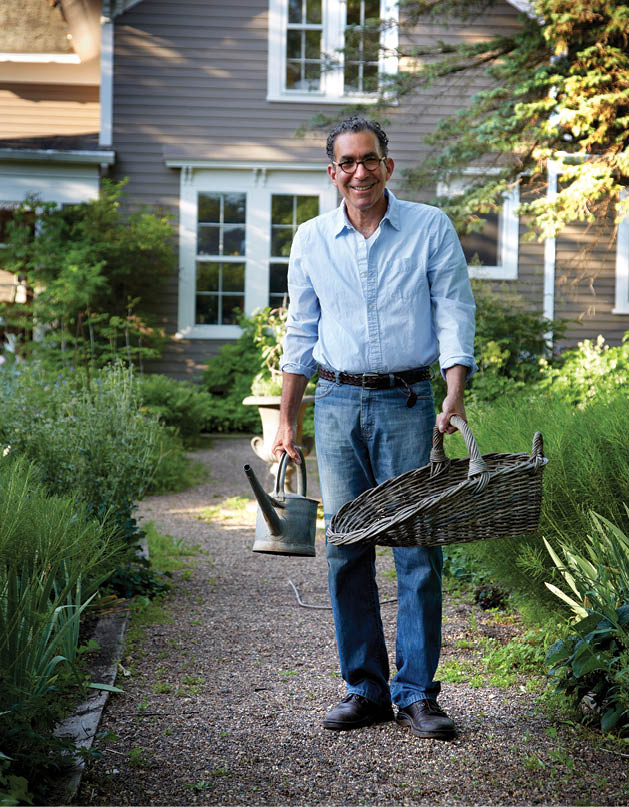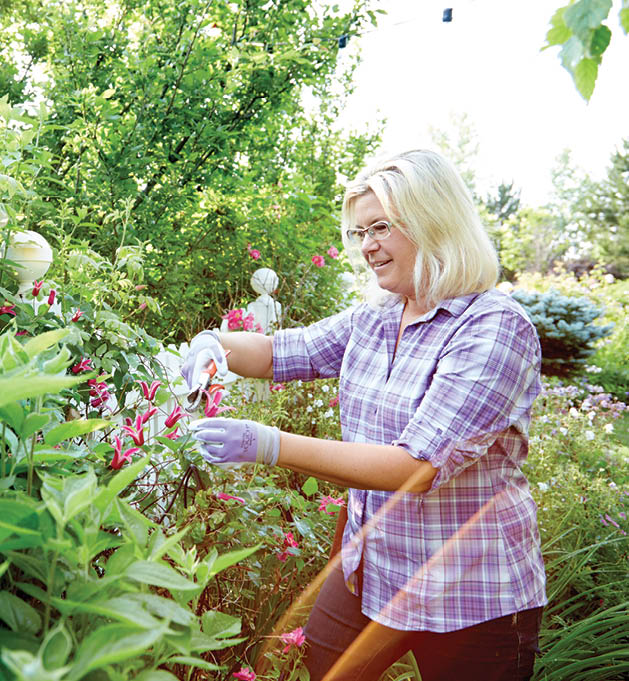If you’re dreaming of a romantic getaway with captivating colors and quaint allure, you might not have to look further than your own yard. Bring the enchantment of Europe to your home, inspired by an English garden design. Whether you like formal and meticulously manicured or a natural cottage style, local experts Martin Stern of Squire House Gardens in Afton and Sarah Buerkley, founder of Sarah’s Cottage Creations in Stillwater, explain how to achieve this charming landscape right here in the St. Croix Valley.
Traditional English garden landscaping is architecturally strong and involves lines that define an area. “The English garden borrows from early styles that had a sense of containment and a sense of privacy,” says Martin Stern, who studied English gardening in Great Britain in summer workshops with John Brookes in 1987. “Main garden beds are often chambers or rooms that are delineated by hedging.” Stern and his partner, Richard Meacock (who also happens to be British) own Squire House Gardens. They offer landscape design services, a gift shop and nursery, as well as host events in their English gardens throughout the year.
“The hedge gives the space shape and definition,” says Sarah Buerkley, owner of Sarah’s Cottage Creations, a full-service landscape design firm that specializes in the cottage-style version. Buerkley has appeared on national TV programs such as Curb Appeal and Landscape Smart, and aspires to help others create the “gardens of their dreams.”
While manicured evergreen hedges can be seen across Europe, our Minnesota climate allows for a limited choice of hedging material for our growing zone.
“There are types of boxwood that are hearty in our zone that are beautiful and amazing, and they can give you evergreen spring, summer, winter, fall,” Buerkley says. “Chicagoland boxwood and green velvet boxwood have a round shape, and green mountain boxwood has a cone shape. The maximum height they would be is 2 feet tall. You can keep them down to a foot tall, if you want to accent an annual bed or a fountain.”
“For larger evergreen hedges, typically we use arborvitaes,” Sterns adds. “You can also use deciduous material. Any shrub, such as burning bush, that looks good as a hedge can be used as well. It’s very dense. It’s not evergreen, but it does create that sensible wall.”
Along with the hedging, English gardens are known for well-defined beds with lush plantings of diverse varietals.
“You want different heights. You can incorporate trees, shrubs, perennials and annuals, all working together to give you that lush look,” Buerkley says.

Stern advises to begin with perennials that offer year-round color. “The use of contrasting textures is the best way to show off. Pick four to five really good plants, and repeat that pattern.”
He suggests peony, phlox, lily and cone flower as examples, but notes the choices are really endless, as long as it can grow in our zone. “Find a nice assortment that is harmonious,” he says.
“I like to do drifts of plants, instead of one here, one there, to give you a lush, rolling look where you don’t see a lot of mulch,” Buerkley says. “Perennials I like to use in drifts are Nepeta and Lady’s Mantel. They are super hardy, very easy, and great for ground cover.”
Another defining characteristic of the English garden is a pathway system that has points of interest marked and emphasized by things such as benches and statues.
“English gardens have pretty clear lines, and there is an intention to where the paths are leading,” says Stern, who adds that ornament is important. “Benches, urns and statuary play a fairly significant role. Arbors, pergolas and trellises often show up.”
Buerkley agrees: “I always love to add some sort of garden art,” she says. “You can find cool stuff at garden centers. I love water fountains. Urns and planters give you the form or the art piece, and add a different texture.”
If you’re toying with the idea of an English garden for your landscape, here are a few additional considerations.


“A good garden is based on context. It’s easier for a garden to complement a house, and a lot of home facades borrow from European styles,” Stern says. “On the other hand, if you have a very contemporary, prairie or highly stylized home, you’ll want a garden that matches.”
“To give it the feel of an English garden, [you’ll] usually need a bigger space, something large enough to add all of these elements. It could be a courtyard leading to your front door [that] makes a really cool English garden, or it could be an area in the back, like a spot you see out of your kitchen window that you want to be a collection of plants,” Buerkley says. “Don’t be afraid to clear the land if you need to. You don’t have to keep what’s there.”
If you don’t have space, you also can consider using pots, planters or window boxes to achieve some of the looks. “I’ve put boxwood in window boxes before,” she adds. “That is one way of getting the look added to your house. But the window boxes need to be big. It needs to be 12 inches deep and 12 inches wide. It needs to be large enough to hold enough soil so that those flowers can grow to their maximum size through October. And put new soil in every year.”
Both experts agree that doing research will help you. Go to the arboretum, collect pictures of what you like in plant books, or search online for plants of Minnesota. Your gardening expertise will determine how much help you need.
“If you’re going to do anything in the garden, soil prep is so important,” Buerkley says. “Adding compost and top dressing with manure makes a huge difference—it changes the soil. It’s like insurance for your plants. Fill it in a good 6 inches, then you plant in it, and it’s just amazing.”
“American gardeners these days want it easy, and that’s not what an English garden is,” Stern concludes. “It can be designed around. I do designs for people who aren’t gardeners that still have an English feel to them, but they’re just not as prolific. If you want a beautiful, ebullient English garden look with lots of birds and butterflies, then you do need to make an investment of energy and labor. A professional can help you put together a plan.”










